We make images sharper
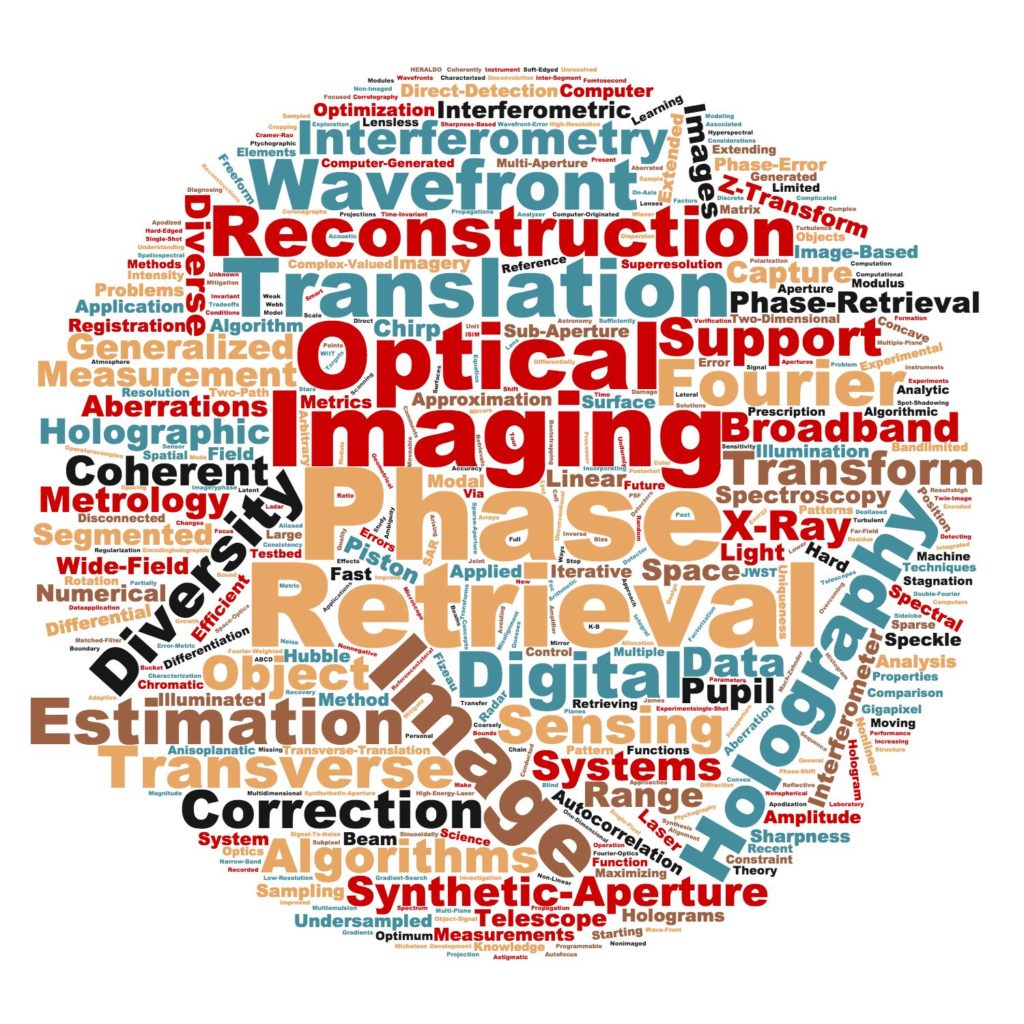
Titles of Publications analyzed by WordCloud. Click on the graphic to enlarge it.- Click here to see a recent story of how our group and others from the University of Rochester contributed to making the James Webb Space Telescope a success.
- Click here to see a recent story on Matt Banet’s winning of the US Air Force’s Dr. Samuel Blankenship Directed Energy Scholar Award. Matt had previously won a SMART scholarship.
- Click here to see a recent story on our work on the James Webb Space Telescope.
- Click here to see a recent story on Manuel Guizar’s winning the ICO Prize for 2019.
- Click here to see a recent story on former group member Abbie (Tippie) Watnik’s advice on staying connected.
We perform research in the areas of:
- Unconventional imaging
- Phase retrieval
- Wavefront sensing
- Imaging with sparse-aperture telescopes
- Image reconstruction algorithms
Recently published papers
(available under Publications tab)
“Fourier-optics imaging analysis with ABCD matrices: tutorial,” J.R. Fienup, J. Opt. Soc. Am. A 41, 2361-2370 (2024).
By Ganesh Petterson:
G.D. Petterson, M.T. Banet and J.R. Fienup, “Post-processing techniques for the reduction of range chatter in 3D holographic imaging with a pilot tone,” in “Unconventional Imaging, Sensing, and Adaptive Optics 2025,” Proc. SPIE 136191M (2025). https://doi.org/10.1117/12.3063946
By Natalia Sanchez Soria:
N. Sanchez-Soria, S.D. Will and J.R. Fienup, “Coronagraph image postprocessing comparison under wavefront drift,” in “Techniques and Instrumentation for Detection of Exoplanets XII,” Proc. SPIE 136270R (2025). https://doi.org/10.1117/12.3064540
By Yaocheng Sparrow Tian:
Phase retrieval with only a nonnegativity constraint,” Opt. Letters 48, 135-138 (2023).
By Matthias Banet:
“Simulating speckle fields in deep turbulence via wave optics: Angular spectrum method versus sinc-basis propagation,” M.T. Banet, K. Luna and J.R. Fienup, Proc. SPIE 13149 -131490P (2024). DOI: https://doi.org/10.1117/12.3027682
“Demonstration of multi-plane sharpness metric maximization on motion-compensated, multi-wavelength 3D digital holographic field data,” Opt. Lett., 49, 418-421 (2024). DOI: 10.1364/OL.499173
“Multiplexed, multi-wavelength 3D digital holographic imaging methods with range unwrapping,” Proc. SPIE 1269304 (2023). doi: 10.1117/12.2676428.
“Speckle decorrelation effects on motion-compensated, multi-wavelength 3D digital holography: theory and simulations,” Opt. Eng 62(7), 073103 (2023), doi: 10.1117/1.OE.62.7.073103.
“3D multi-plane sharpness metric maximization with variable corrective phase screens,” Appl. Opt. 60, G243-G252 (2021).
“Subaperture sampling for digital-holography applications involving atmospheric turbulence,” Appl. Opt. 60, G30-G39 (2021).
“Compensated-beacon adaptive optics using least-squares phase reconstruction,” Opt. Express 28, 36902-36914 (2020).
By Joseph Tang: “Using a broadband long-wavelength channel to increase the capture range of segment piston phase retrieval for segmented-aperture systems,” Appl. Opt. 63, 3863-3875 (2024).
“Integrating Bias and Gain Invariance with the Generalized Anscombe Transform for Wavefront Sensing,” Proc. SPIE 1144348 (2020).
By Scott Will: “High-order coronagraphic wavefront control with algorithmic differentiation: first experimental demonstration,” J. Astron. Telesc. Instrum. Syst. 9(4), 045004 (2023).
“Jacobian-free coronagraphic wavefront control using nonlinear optimization,” J. Astron. Telesc. Instrum. Syst. 7(1), 019002 (2021).
“An algorithm for exact area-weighted antialiasing of discrete circular apertures,” J. Opt. Soc. Am. A 37, 688-696 (2020).
“Field stop diffraction and sampling effects in apodized pupil Lyot coronagraphs,” J. Opt. Soc. Am. A 37, 629-642 (2020).
A famous paper
One of Prof. Fienup’s papers [J.R. Fienup, “Phase Retrieval Algorithms: a Comparison,” Appl. Opt. 21, 2758-2769 (1982)] has received over 7,000 citations (Google Scholar) and is the most highly cited paper (out of over 50,000) in the journal Applied Optics.
Examples of research problems:
NASA’s James Webb Space Telescope
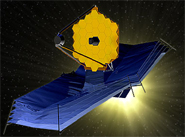
NASA’s James Webb Space Telescope will need phase retrieval to align the 18 segments of the primary mirror. Similar phase retrieval algorithms were used to determine how to fix the Hubble Space Telescope. NASA’s Wide-Field Infrared Survey Telescope (WFIRST), although not segmented, will need precise knowledge of its small wavefront aberrations for exoplanet direct imaging and microlensing, which can be determined with phase retrieval. NASA’s proposed Large UV/Optical/Infrared (LUVOIR) Surveyer telescope will include coronagraph instruments that will be able to image dim planets orbiting bright stars. It will require exquisite wavefront control and highly accurate modeling of the coronagraph optics.
Astronomers and DoD are interested in imaging interferometry
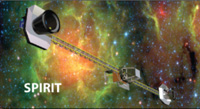
using two or more well-separated, small telescopes to obtain images having the fine resolution of a single, much larger telescope, as illustrated here by NASA’s SPace InfraRed Interferometric Telescope (SPIRIT) concept. We are interested in image and spectral reconstruction despite uncertainties in alignment and motion, incomplete data, and, for ground-based systems, atmospheric turbulence. We are currently applying these techniques to the problem of imaging geosynchronous satellites from the earth, despite atmospheric turbulence, and of wide-field infrared astronomical imaging.
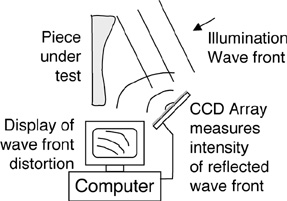
Phase retrieval algorithms can be used to perform optical metrology, testing aspheric optical surfaces during their manufacture with a simple system not requiring a null lens. We are developing these ideas for measuring free-form optical surfaces.
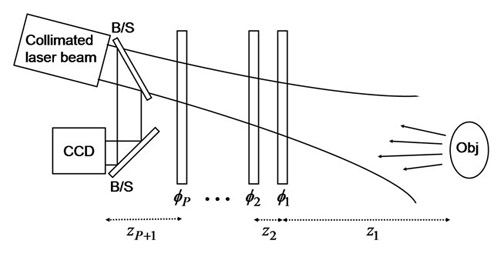
Image sharpening algorithms can be used to estimate multiple phase screens throughout a volume of turbulence and reconstruct fine-resolution images of objects, despite the space-variant blurring effects of atmospheric turbulence.
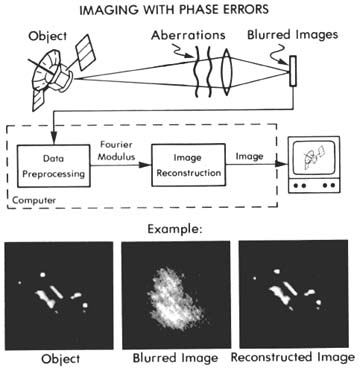
Phase retrieval algorithms can be used to reconstruct fine-resolution images of satellites and astronomical objects, despite the blurring effects of atmospheric turbulence.
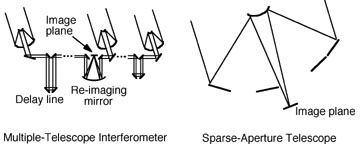
Telescopes having sparse apertures or are made up of an array of multiple smaller telescopes can give fine resolution images, while having large savings on size and weight. Image restoration and phase retrieval (to align the sub-apertures) are needed to achieve good quality imagery.
